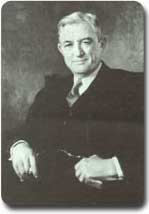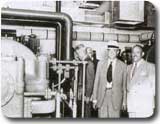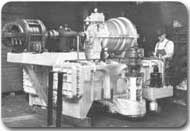Willis Havilland Carrier, known to many as "The Father of the modern Air Conditioner" was born on November 26, 1875 on his families farm in a small town in Angola, New York. His father Duane was in charge of the family farm while his mother Elizabeth was in charge of fixing sewing machines, clocks and other machinery found on their farm a skill which Willis readily absorbed. His mother also taught him his love of math and problem solving before passing away while he was still young. Willis was a creative child who studied hard and kept himself busy by creating problems and solving them. Willis dreamed of bigger things that life on a small farm and decided at a young age to become an engineer. He eventually landed a state scholarship to Cornell University where he met his first wife, Edith who he would go on to marry in 1902. He graduated in 1901 with a masters degree in mechanical engineering and became an employee at the Buffalo Forge Company, with a starting salary of a modest $10.00 per week.

The Buffalo Forge Co. who excelled in manufacturing heaters, blowers, and air exhaust gave him the job title of heating engineer in the newly created experimental science department of their company. The first task they assigned him was to deal with a problem at a Brooklyn printing plant. Only 25 at the time the very bright young man quickly identified the source of the problem which stemmed from fluctuations in heat and humidity. This variation caused the paper to expand and contract just enough to ensure the misalignment of the colored ink. He determined what the proper moisture level for printing was by using the national weather tables to calculate the precise temperature which would maintain the appropriate humidity level.
He then went to work on designing a new machine which would control both heat and humidity and create a stable environment in which reliable four color printing was possible. Carrier was inspired with the idea for his apparatus while waiting for a train on a foggy night. By the time the train arrived Carrier had gained a deep understanding of the relationships between temperature, humidity and the dew point. In 1902 he designed his spray driven air conditioning system which controlled both temperature and humidity using a nozzle originally designed to spray insecticide. He built his "Apparatus for Treating Air" (U.S. Pat. #808897) which was patented in 1906 and using chilled coils which not only controlled heat but could lower the humidity to as low as 55%. The device was even able to adjust the humidity level to a desired setting creating what would become the framework for the modern air conditioner. By adjusting the air movement and temperature level to the refrigeration coils he was able to determine the size and capacity of the unit to match the need of his customers. While Carrier was not the first to design a system like this his was much more stable, successful and safer that other versions and took air conditioning out of the dark ages and into the realm of science.

The first air conditioning units were very large, very expensive, and still quite dangerous because the ammonia that was used as coolant was highly toxic. Shortly after he built the industrial system for the printing plant he designed a system for use in offices, apartments, hotels, and hospitals. Many call him the father of air conditioning because his companies became synonymous with air conditioning excellence.
In 1911 Willis Carrier presented to the American Society of Mechanical Engineers the 'Rational Psychometric Formula' which is still used today by the air conditioning industry and by 1914 Carrier had designed and installed air conditioning systems for manufacturing plants, department stores, soap, rubber and tobacco factories, breweries, bakeries, food processing plants and others.
Willis joined with six other engineers; Edmund Heckel, Ernest Lyle, Alfred Stacey Jr, Logan Lewis, Irvine Lyle, and Edward Murphy to create the Carrier Engineering Corporation in 1915 with a modest budget of only $32,600 which they invested from their own savings. The company was originally located in New Jersey and was based on the ideal of improving existing air conditioning technology. Early projects focused on commercial applications, but they quickly began to apply air conditioning public applications.

In 1921, Carrier invented the centrifugal chiller which allowed his company to air condition very large spaces. Earlier air conditioners used piston driven compressors to pump refrigerant but Carrier designed a compressor modeled after the centrifugal turning blades of a water pump. This design proved to be safer and much more efficient allowing for larger designs.
In 1922 Willis Carrier made two critical breakthroughs. First he replaced the toxic coolant ammonia with the much safer coolant dielene. Secondly he greatly reduced the size of the units. This led to air conditioning units being installed places like department stores, office buildings, railroad cars and other small buildings.
In 1924 three Carrier centrifugal chillers were installed in the J. L. Hudson Department Store in Detroit, Michigan. Shoppers were greatly pleased and intrigued by the air conditioned store and air conditioning became a marketing tool for many retail businesses. In 1928, Carrier developed a residential air conditioner for private homes called the "Weathermaker".

He installed air conditioning systems in the Madison Square Garden, the U.S. Senate and House of Representatives and the White House, as well as many other important buildings. He installed the world's first residential air conditioning system in a home in Minneapolis, Minn. in 1914. It was owned by Charles Gates who was the son of notorious gambler John "Bet a Million" Gates. His company would eventually design air conditioning systems for the first bus, railroad cars, planes and even atomic submarines.
Carrier moved his company's headquarters to Syracuse, New York in 1930 where it is still located today. He also started a division of Carrier in Japan in 1930 allowing him to position his company as a work leader in this technology.
The Great Depression slowed the residential and light commercial use of air-conditioning. Willis Carrier's igloo in the 1939 World's Fair gave visitors a glimpse into the future of air conditioning but before it could catch on World War II began.
Like many manufacturers, Carrier converted their production to military use during World War II. Carrier systems were used in the production of synthetic rubber and in high octane gasoline both of which were vital to the war effort. Carrier chillers were removed from department stores including Macy's department store for installation in military production plants and were returned after the war. Carrier air conditioning and refrigeration equipment was used for warships, cargo vessels, munitions plants, and factories specializing in the production of such essential war material as bombsights and other precision instruments. Carrier made thousands of refrigeration units for walk-in coolers which were used by the Navy to keep food and other perishables fresh. Special portable air conditioners were made for servicing airplanes in hot climates. Carrier also turned out airplane engine mounts, sight hoods for guns, tank adapters and other military items.

Perhaps the greatest of all of Carrier's contributions to the war effort was something Willis Carrier called his own greatest engineering achievement. He designed a system for the National Advisory Committee for Aeronautics to simulate freezing, high altitude conditions for the testing of airplanes, a marvel that up to this time was thought impossible by most. Carrier was awarded the Army and Navy "E" six times, an honor attained by only 13 other companies.
On Oct. 9, 1950 Willis Carrier died just shy of his 74th birthday but his contributions to the air conditioning industry live on and his modest company is now a global corporation which continues to grow and thrive. Thanks in part to his contribution to refrigeration science death rates have dropped, and economic activity during the summer months has soared. Working conditions have improved greatly along with productivity and worker satisfaction. Migration to the South increased and helped to create huge cities and suburbs where once there had been small stagnant sweltering cities because air conditioning allowed sky scrapers and other unconventional structures to be built and freed architects to build how and where they wanted, leading to a building revolution. In 1969 refrigeration technology helped to facilitate a trip to the moon. Neil Armstrong and Buzz Aldrin walked on the moon in space suits with cooling systems which protected them from the uninhabitable ravages of outer space. Refrigeration has helped in space exploration from the early walks on the moon to the sophisticated system on the Mir space station. These are just a few of the contributions from a small boy born as Willis Havilland Carrier from a small town in Angola, New York who dreamed of bigger things.
In 1995 Carrier corporation and their subsidiaries sales were over $5 billion dollars and growing.






















